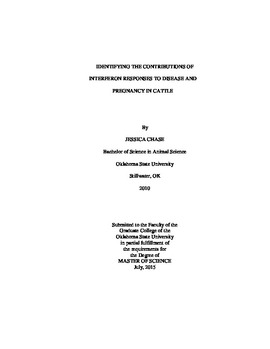| dc.contributor.advisor | Hernandez Gifford, Jennifer | |
| dc.contributor.author | Chase, Jessica Lee | |
| dc.date.accessioned | 2016-09-29T18:38:57Z | |
| dc.date.available | 2016-09-29T18:38:57Z | |
| dc.date.issued | 2015-07-01 | |
| dc.identifier.uri | https://hdl.handle.net/11244/45239 | |
| dc.description.abstract | Two significant challenges the cattle industry is facing are respiratory disease and infertility. The type I interferon (IFN) pathway plays a pivotal role in both disease and pregnancy. The type I IFN pathway is interrupted by viral infection which reduces production of interferon stimulated genes (ISG). Interferon-tau (IFNT) is the pregnancy recognition signal in ruminants, which acts through the type I IFN pathway to activate ISG. Thus, understanding IFN and immune function could improve production efficiency. Studies described herein evaluate type I IFN and immune responses to bovine respiratory disease and pregnancy recognition in cattle.The first experiment evaluated activation of the type I IFN pathway after infecting calves with bovine viral diarrhea virus type 1b (BVDV1b) and Mannheimia haemolytica (MH). Steady-state mRNA levels of MX1, ISG15, and RTP4 were determined in peripheral blood leukocytes prior to BVDV1b exposure (d -4), prior to MH challenge (0 h), 12 h and 24 h after MH challenge. A significant time effect (P < 0.05) for all ISG was detected. At 0 h, ISG15 levels increased 44-fold and remained elevated over 60-fold for 12 h and 24 h (P < 0.01). Likewise, RTP4 and MX1 increased at 12 h (P < 0.05) after BVDV challenge. Data suggests that the type I IFN pathway remains active after challenge with BVDV1b and MH.The second experiment evaluated pregnancy rates after intrauterine, autologous transfer of IFNT-primed immune cells. Peripheral blood mononuclear cells were cultured overnight with 500 U/mL of IFNT, followed by autologous intrauterine transfer (IMMUNE; n = 97) on d 4 after estrus; controls received intrauterine infusion of saline (CONT; n = 82). On d 7, serum samples were collected for hormone analysis and embryos were transferred to all animals. Progesterone concentrations were similar for IMMUNE (4.1 � 0.33 ng/mL) and CONT (3.7 � 0.33 ng/mL) and were not different between pregnant and open cows (P > 0.2). Pregnancy rate for IMMUNE was 77% (75/97) compared with 57% (47/82) for CONT (P < 0.01). Results indicate that progesterone concentrations did not differ between groups and transfer of autologous IFNT-primed PBMC improved pregnancy rates after embryo transfer. | |
| dc.format | application/pdf | |
| dc.language | en_US | |
| dc.rights | Copyright is held by the author who has granted the Oklahoma State University Library the non-exclusive right to share this material in its institutional repository. Contact Digital Library Services at lib-dls@okstate.edu or 405-744-9161 for the permission policy on the use, reproduction or distribution of this material. | |
| dc.title | Identifying the Contributions of Interferon Responses to Disease and Pregnancy in Cattle | |
| dc.type | text | |
| dc.contributor.committeeMember | Giffor, Craig | |
| dc.contributor.committeeMember | Lalman, David | |
| osu.filename | Chase_okstate_0664M_14094.pdf | |
| osu.accesstype | Open Access | |
| dc.description.department | Animal Science | |
| dc.type.genre | Thesis | |
